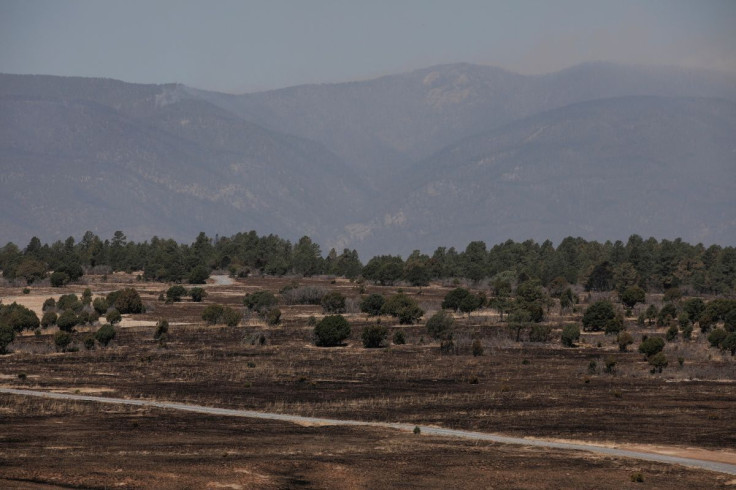Under An Orange Sky, Largest U.S. Wildfire Menaces New Mexico Towns

Firefighters in northern New Mexico labored under an apocalyptic orange sky, and vehicles streamed out of the ski area of Angel Fire on Wednesday as wind-driven flames from the state's second-largest blaze on record roared closer to the mountain resort.
With winds gusting beyond 50 mph (80 kmh) through dense, drought-parched forests, exhausted crews were at loss to stop a wildfire that has raged across a 45-mile swath of the Sangre de Cristo Mountains for more than a month, destroying hundreds of homes.
Spreading through the rugged, tinder-dry landscape with explosive speed, the springtime conflagration has displaced thousands of residents while raising fears that the entire American Southwest was in for a long, brutal fire season.
As smoke hung heavy outside Angel Fire's supermarket, Almeada Martinson said she planned to pack her photos, guns, two dogs and cat, then evacuate to Taos, 17 miles to the west.
"I'm totally anxious and terrified. This is my home," said Martinson, 35, general manager of a construction business, as ash swirled around her feet.
The Sangre de Cristo mountains, soaring to over 13,000 feet, have traditionally seen spring storms dumping more than 2 feet of snow. But climate change has diminished the snowpack and brought summer-like temperatures earlier in the year, biologists say, drying out the region and leaving communities more vulnerable to fire.
At Angel Fire's airstrip, strong winds grounded firefighting helicopters. Seven miles to the south at Black Lake, firefighters huddled around a map and discussed which properties they could try to save.
In immediate danger was the village of Chacon, where locals faced flames on two sides after they stayed behind to defend centuries-old ranches, firefighters said.
To the north, residents of Taos Canyon cut down their own trees to create fire buffers around homes. About 4 miles farther west of downtown Taos - the heart of an area inhabited by indigenous people for 1,000 years - residents were advised to be ready to evacuate on short notice.
At a news briefing late in the day, however, battalion fire chief Todd Abel said the leading edge of the blaze appeared to be heading more toward the north and east, in a direction that would hopefully skirt Taos, a town of about 5,700 people.
In another piece of good news, authorities said mandatory evacuation orders were being lifted on Wednesday evening for a string of small Mora County communities, though other populated areas on the northern edge of the blaze were newly threatened.
Although unseasonably warm temperatures and extreme low humidity will persist in the days ahead, winds that have howled with gale-force strength for nearly a week are expected to subside on Friday, giving firefighters a bit of a respite, forecasters said.
The blaze, dubbed the Hermits Peak/Calf Canyon fire, has burned over 236,939 acres (95,885 hectares) of land, an area larger than all five boroughs of New York City, with containment lines carved around about a third of its perimeter as of Wednesday evening.
The fire grew out of two blazes that ignited about two weeks apart and later merged into one, the first originating from a prescribed-burn project that ran out of control, according to fire officials. The cause of the second remained under investigation.
In addition to climate change, a century of strict fire suppression and court bans on logging since the 1990s have helped transform New Mexico's northern forests into overgrown, highly combustible fuel beds, scientists say.
© Copyright Thomson Reuters 2024. All rights reserved.







